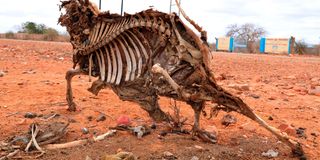More Kenyans hungry in 2022 compared to 2021

A cow carcass that died due to the ongoing drought in Wargadud, Mandera County in this photo taken on July 19, 2022. For the last three consecutive years, the county has not received any rainfall.
What you need to know:
About 3.5 million people in the Arid and Semi-Arid Lands (Asal) in Kenya are facing high levels of acute food insecurity, a report by a multi-partner agency.
The Integrated Food Security Phase Classification (IPC), in a report compiled between July and September, says this represents a whopping 24 percent of the Asal population. Persistent drought, coupled with high commodity prices, poor trade conditions and high inflation are contributing to the situation. This is a 10 percent increase from the same period in 2021 where 2.1 million people were affected.
The study shows the food insecurity is primarily driven by a combination of shocks, including a fourth successive below-average rainy season which resulted in below average crop production and poor livestock production; localised resource-based conflict; and high food prices as a result of the war in Ukraine and low in-country production.
The most affected counties are predominantly pastoral. They represent 40 percent of the country’s population. They are Isiolo and Turkana, which are 50 percent affected; Garissa, Mandera, Marsabit, Samburu and Wajir at 45 percent; and Baringo at 40 percent.
In the projected period of between October and December 2022, the analysis indicates, the food security situation is likely to worsen, and more people may require urgent action to reduce food gaps and protect their livelihoods. About 4.4 million people are projected to face high levels of acute food insecurity.
Emergency
Overall, 3.1 million people (21 percent of the population analysed) will likely be in crisis and 1.2 million people (eight percent of the population analysed) in emergency.
Things are not projected to improve, as above-average staple food prices driven by low production and limited supplies, combined with inadequate income from agricultural-waged labour opportunities and crop sales will continue to limit household food access in regions that depend on crop and livestock production.
Furthermore, livestock body conditions and productivity are expected to deteriorate due to declining forage and water availability. This will likely result in a decline in household access to food and income, as milk production and livestock sale value are highly affected by the absence of pasture and water.
The nutrition situation has significantly deteriorated across the counties compared to the same season last year.
Based on the July 2022 analysis, malnutrition levels were extremely critical in Turkana North, Turkana South and Laisamis sub-counties, critical in Mandera, Garissa, Turkana West, Turkana central, Wajir, Isiolo, Samburu, North Horr, and Tiaty in Baringo County. Saku, Tana River and West Pokot Counties were classified in serious, while Moyale at alert level.



